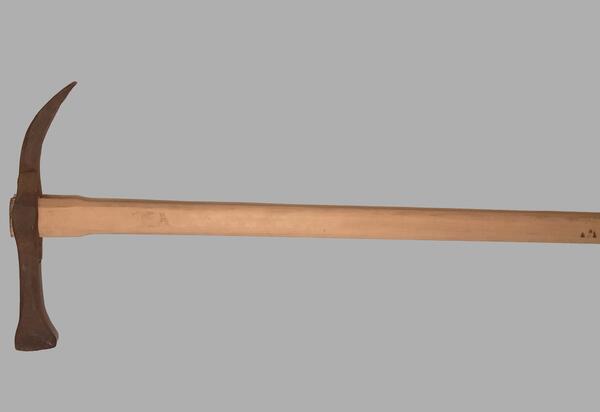A pickaxe is a hand-held striking tool designed for breaking any kind of rock, stone, or old brickwork. In the past, it was widely used in geology and mining, as well as construction. In fact, it was often utilized in geological exploration even back in the early 20th century.
A pickaxe is a long, flat hammer with a sharp head that is attached perpendicularly to its handle. Like a sledgehammer, it allows its wielder to strike the material being cut with great force. Based on their striking properties, pickaxes are classified into two categories, which include single-point and double-point picks. The pickaxe was the predecessor of the ice pick, and could have served as a formidable weapon in the past: a type of a pickaxe designed specifically for military purposes is called bec de corbin. A rock pick differs from a pickaxe in that the former is usually hit with a hammer, while the latter is used as an independent striking tool. That is why most of the time pickaxes have two points, while rock picks do not.
The length of a pickaxe usually ranges from 20 to 130 cm, while the length of the head is normally between 7 and 30 cm. The head is usually forged from hard metal, while the handle is made of wood (like in the case of the tool presented in the Ishimbay Museum of History and Local Lore) or a softer and lighter metal, such as aluminum. A pickaxe head has an oval through hole in its center for attaching the tool’s handle, as well as two blades pointed in opposite directions, or a single blade and a flat hammer intended for driving large nails or breaking rocks. When viewed from the side, a pickaxe head usually has the shape of a curve or an arch.
The pickaxe is quite an ancient tool, and these days it is more commonly used in underdeveloped countries and, on rare occasions, by geologists and miners. Nevertheless, even in the recent past, as late as the first half of the 20th century, a pickaxe was a common sight in the hands of geologists, miners, and construction workers. It should be noted that a pickaxe is a very heavy and dangerous tool that can deal an extremely damaging blow if it misses its target or is used without due caution. Since its head is heavy and has very sharp points, a hit from a pickaxe can cause serious injury or even kill a person.
A pickaxe is a long, flat hammer with a sharp head that is attached perpendicularly to its handle. Like a sledgehammer, it allows its wielder to strike the material being cut with great force. Based on their striking properties, pickaxes are classified into two categories, which include single-point and double-point picks. The pickaxe was the predecessor of the ice pick, and could have served as a formidable weapon in the past: a type of a pickaxe designed specifically for military purposes is called bec de corbin. A rock pick differs from a pickaxe in that the former is usually hit with a hammer, while the latter is used as an independent striking tool. That is why most of the time pickaxes have two points, while rock picks do not.
The length of a pickaxe usually ranges from 20 to 130 cm, while the length of the head is normally between 7 and 30 cm. The head is usually forged from hard metal, while the handle is made of wood (like in the case of the tool presented in the Ishimbay Museum of History and Local Lore) or a softer and lighter metal, such as aluminum. A pickaxe head has an oval through hole in its center for attaching the tool’s handle, as well as two blades pointed in opposite directions, or a single blade and a flat hammer intended for driving large nails or breaking rocks. When viewed from the side, a pickaxe head usually has the shape of a curve or an arch.
The pickaxe is quite an ancient tool, and these days it is more commonly used in underdeveloped countries and, on rare occasions, by geologists and miners. Nevertheless, even in the recent past, as late as the first half of the 20th century, a pickaxe was a common sight in the hands of geologists, miners, and construction workers. It should be noted that a pickaxe is a very heavy and dangerous tool that can deal an extremely damaging blow if it misses its target or is used without due caution. Since its head is heavy and has very sharp points, a hit from a pickaxe can cause serious injury or even kill a person.



